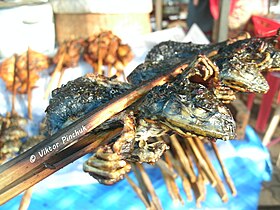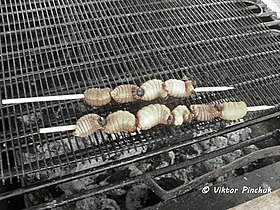Basics of fine-art photography/Photography of exotic (extraordinary) dishes

Photo taken on a Papuan expedition)

Photo taken on a Papuan expedition)
Photography exotic (extraordinary) food is a hybrid of two genres: food photography and travel photography.
Geberal information
[edit | edit source]Prerequisites of emergence
[edit | edit source]Food photography, in the classical sense, serves advertising purposes — a group of specialists, using studio effects (professional equipment, special lighting techniques, etc.), creates pictures of food for subsequent publication in magazines, posters, billboards, etc. In this case, the photographed objects are subjected to pre-processing, then exposure arrangement, which corresponds to the principles of staged photography.
Travel photography is a genre whose theme is the impressions of a traveler or tourist: the objects that he sees while moving along the chosen route, including dishes of traditional cuisine of overseas countries.
What this genre is?
[edit | edit source]Exotic food photography emerged by taking the theme of the first of the above genres and the methodology of the second.
On long intercontinental travels (however, as well as on standard tourist trips), there is no way to use a photo studio and carry with you bulky equipment. Work (shooting) in this subgenre involves the spontaneous action of a person who has arrived in a distant country, where many things differ from the usual realities, including dishes of Aboriginal, some of which at first can cause a slight shock.
Ways of implementation
[edit | edit source]Photo works are created in field conditions, spontaneously. Street sellers of exotic food do not always like the manifestation of attention to their product from a foreigner with a camera. For example, in Thailand, on Khaosan Road, where there are no less tourists than locals, vendors of fried scorpions put up a price tag, which indicates the cost of... providing the opportunity to photograph an unusual “product”. The reason is understandable: the number of those wishing to receive a memorable photo significantly outnumbers the number of gourmets.
Taking into account the above, we can conclude, that possibile two options:
- Act quickly and swiftly. When you spot an object of interest, point the lens, press the button on the move and continue on your way. Forget about manual settings: you will have to use the camera's auto mode. In this case, the result of your work may lag behind in quality, but will look more realistic, intersecting with a straight (pure) photography.
- Combining pleasant with the useful, buy a cockroach or a worm for tasting, which will allow you to capture the subject in the right perspective, by choosing the right lighting angle. In addition, in the eyes of the seller, you will acquire the status of a benefactor, increasing (with your symbolic "penny") his daily earnings. As a result, it is possible that he will allow you to take a picture of the cooking process without charging you extra for it. In this case, the photo will be classified as staged.
Carefully consider the photographs of the author of the textbook, in particular, the countries where they were taken.
Gallery
[edit | edit source]-
Fried guinea pig (Equador, 2015)
Photo taken on a Latin American expedition -
Newborn fried chicken (Philippines, 2019)
Photo taken on the Expedition to Oceania -
Frog skewers (Laos, 2013)
Photo taken on a Papuan expedition -
Larvae of the palm weevil (Equador, 2015)
Photo taken on a Latin American expedition
See also
[edit | edit source]Dishes of native cuisine in long intercontinental expeditions
Wikisource
[edit | edit source]Viktor Pinchuk "Very tasty... spider!"




